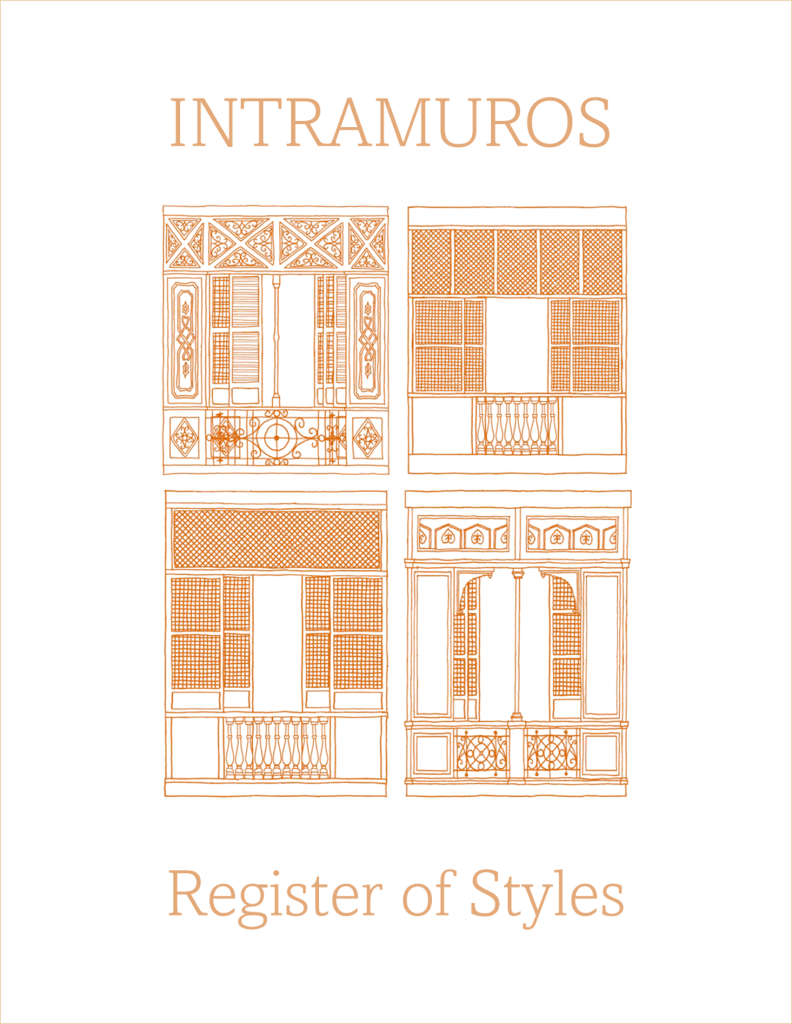What is the Register of Styles?
The Register of Styles is an integral part of the Implementing Rules and Regulations (IRR) of Presidential Decree (PD) No. 1616. As such, in the Intramuros Administration’s (IA) mandate to govern the orderly restoration and development of Intramuros, the Register of Styles serves as a innovation and a key document in guiding the implementation of pre-war architectural colonial styles in Intramuros.

The IA Technical Committee on Architectural Standards
The Technical Committee on Architectural Standards (TCAS) is the main group under the Administration that implements the Register of Styles. Development of properties by private individuals and entities and Government agencies shall be undertaken only after the IA Development Clearance has been issued by the Urban Planning and Community Development Division [Rule III Sec. 1(C)], with a Certificate of Appropriateness from the TCAS as a pre-requisite [Rule VI Sec 10]. All efforts shall be directed toward ensuring that the general appearance and architecture of buildings and structures within Intramuros shall conform to the Philippine colonial architecture of the 1890’s [Rule III Sec. 1(B)]. As such, in the review and deliberation of plans for the issuance of the Certificate of Appropriateness, the TCAS refers to the Register of Styles for guidance [Rule III Sec. 1(C)].
Deviations from the Register of Styles
“Historical Precedents” on designs, as compiled in the Register of Styles, shall be respected and be the primary consideration in allowing or disallowing specific architectural structures or designs [Rule VI Sec. 2(A)]. In this case, “Historical Precedents,” which refers to “any structure, condition or event which has been established as a historical fact by primary sources” [Rule II Sec. 1(d), shall be limited to Primary Sources from Intramuros of the 1890s [Rule VI Sec. 1].
Deviations may be allowed on a limited basis. An architectural design that is not found in the Register of Styles may be allowed, subject to the presentation of primary sources by the developer. As such, the Register shall be updated accordingly and whenever necessary to reflect the latest Primary Sources. Succeeding editions of the Register of Styles shall be adopted upon the approval of the Administrator and shall be posted on the website of the Administration [Rule VI Sec. 2(A)].
A primary source is defined under Rule II Sec. 1(ee) as a “first-hand testimony or direct evidence contemporaneous with the colonial era of Intramuros created by first- hand witnesses. These shall include, among others: (1) original documents such as photographs, maps, sketches, diaries, plans, official government records, speeches, manuscripts, letters, interviews, news film footage, newspaper articles, autobiographies, pamphlets, meeting notes; (2) creative works including poetry, drama, novels, music, art; and (3) relics or artifacts, such as furniture, clothing, buildings, and are characterized by their content regardless of the format.
Historical Context of the Register of Styles
Intramuros in Manila is the only locality in the Philippines where, for cultural reasons, the use, height, scale, and aesthetics of all new constructions and development are pre-determined and strictly regulated under the force of a national law. Curiously however, despite more than four decades of architectural regulations, the IA was able to operate and implement the concept of the “Spanish-era colonial style,” specifically the style of the 1890s, even with the absence of a comprehensive source material on the subject or a codified architectural style manual.
This gap is reflected even in literature. Filipiniana materials on Philippine architecture during the Spanish colonial regime are voluminous—however, this is not the case when contextualized and narrowed down to Intramuros. Several works on Intramuros exist and while all of them discuss the histories of institutions within the Walls, none have so far offered any comprehensive discussion featuring in-depth analyses of styles. Rather than talking about architectural elements and features, existing literature tend to focus on institutional histories when talking about buildings, as seen in Torres (2005), Gatbonton (1985), Javellana (2003), and Laya (1981)–or historical or grand narratives devoid of any architectural approach, such as in the case of Myrick (1971) and Reed (1978). Moreover, there is no comprehensive discussion on the Bahay na Bato beyond residential uses, and extant literature tend to focus on the Bahay na Bato as residential, as seen in Zialcita and Tinio (1981), Salvan (1986), Alarcon (2008), Laya (2014), Florendo (2012), Fernandez (2015). This perpetuates the myth that the Bahay na Bato is exclusively residential.
The result of this knowledge gap is evident in the present built environment of Intramuros. While many buildings built over the last 40 years are consistent with the historical styles and form of structures in Intramuros by the end of the 19th century, the style of equally many new constructions were left to the liberal interpretation of developers–resulting in several of them, while attempting the “colonial look,” having modernist eclectic and sometimes even Avant Garde appearances entirely inconsistent with the unique colonial identity of Intramuros.
The Register of Styles was developed as an innovation to address this gap. First conceptualized in 2014 as the Style Book, the Register of Styles aims to be a comprehensive source material on colonial styles in Intramuros. Primarily covering architectural styles, the Register also includes references to urban forms and design principles as well.
The Register of Styles was completed in 2021 by Rancho Arcilla, then the Coordinator of the IA Center for Intramuros Studies. The architectural provisions of the IRR was also based on Arcilla’s MA thesis Walls within Walls the Architecture of Intramuros (2021).
Click this link to view a copy of the Register of Styles
Note: The Register of Styles is regularly updated to reflect the latest primary sources. All historical editions of the Register of Styles shall be compiled here. For developers or researchers, make sure to regularly check this site to download the latest edition.
- Register of Styles First Edition, 17 January 2021 (Originally published at the Official Gazette of the Philippines)




